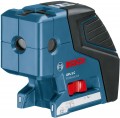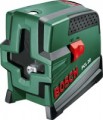Suitable for
General purpose of the device.
This parameter is indicated for models that have a clear specialization - these are mainly laser levels, including rotary ones. Among such devices, there are the following application options:
for the 360° area, only
for point projections,
for the floor and
for pipes. Here are the features of each of these varieties:
— For 360° area coverage. A full circle, 360°, by definition covers all rotary levels (see “Type”). However, such specialization can also occur in “regular” laser models. In such devices, full 360° coverage is achieved in other ways - usually by the presence of several emitters, each of which covers its own sector, or a special prism that scatters the beam from one emitter over a full 360°.
- Point projections only. Levels with this feature do not form marks in the form of lines during operation and “draw” only points. At the same time, in the simplest models there is only one point projection, but devices with several marks (up to 5) are more common. In any case, such devices are intended for relatively simple work where there is no need for marking along lines.
- For the floor. Levels designed for working with floors - screeds, laying coverings, etc. A common feature of such devices is a fairly wide base, which allows, in fact, to place the device di
...rectly on the floor. But the specific design and operating features of levels of this type may be different. Thus, devices with a characteristic layout are quite popular - with two vertical projections intersecting at an angle of 90° (some models provide two more projections directed in opposite directions from the main ones). Such a device can be used not only on the floor, but also on walls: if you press its base tightly against a particular surface, it will form two clearly perpendicular lines on it. In the case of floors, this can be convenient, for example, when laying tiles.
Another common type of floor level is devices designed to detect unevenness. To do this, use a line formed on the floor using a vertical projection. During operation, a level placed on the floor and aligned horizontally rotates around a vertical axis, and the line “scans” the floor; when it hits a ledge, it becomes uneven. Note that in the simplest models, such a “scanner” uses only one projection, but there is also a more advanced version - a line created by two projections at once. Such a pointer, when it hits an uneven floor, is divided into two separate lines - this is much more noticeable than the deviation when using a single projection.
- For pipes. A rather rare type of specialized laser levels are devices for laying pipelines. They are used, in particular, in the construction of water supply, sewer and stormwater systems. Pipe levels most often have a characteristic cylindrical shape, with a handle at one end and a point laser emitter at the other. They are installed horizontally on special legs (the kit usually comes with several sets of such legs, varying in height); the design usually has a self-leveling mechanism with quite extensive capabilities; and the necessary measurement accuracy is ensured by a target with special markings. Such devices allow you to at least accurately lay horizontal lines, and many of them also allow you to work with corners.Measurement range
The range at which the device remains fully operational without the use of additional receivers (see below); in other words, the radius of its action without auxiliary devices.
In some models, a range may be specified that shows the minimum (
3 cm,
5 cm) and maximum measurement ranges. But in most cases, only the maximum value is indicated.
The specific meaning of this parameter is determined by the type of instrument (see above). So, for optical levels, the measurement range is the greatest distance at which the operator can normally see the divisions of a standard leveling staff. For laser levels, this parameter determines the distance from the device to the surface on which the mark is projected, at which this projection will be easily visible to the naked eye; and in rangefinders we are talking about the greatest distance that can be measured. Typically, the measurement range is indicated for ideal conditions - in particular, in the absence of impurities in the air; in practice, it may be less due to dust, fog, or vice versa, bright sunlight "overlapping" the mark. At the same time, tools of the same type can be compared according to this characteristic.
Note that it is worth choosing a device according to the range of action, taking into account the features of the tasks that are planned to be solved with its help: after all, a large measurement range usually significa
...ntly affects the dimensions, weight, power consumption and price, but it is far from always required. For example, it hardly makes sense to look for a powerful laser level at 30-40 m if you need a device for finishing work in standard apartments.Accuracy
Accuracy is described as the maximum deviation from the true value of the measured parameter, which the device can give if all the rules for its operation and the corresponding measurements are observed. In both rangefinders and levels, this parameter is usually designated for a certain distance — for example, 3 mm at 30 m; but even for one manufacturer, these "control" distances may be different. Therefore, in our catalog, the accuracy of all devices is recalculated for 1 m distance; with such a record, for the example above, it will be 3/30 \u003d 0.1 mm / m. This makes it easier to compare different models with each other.
It is also worth mentioning that the meaning of the "accuracy" parameter for different types of measuring instruments (see "Type") will be different. For optical levels, it is described in the "SKP" paragraph above. For laser levels of all types, accuracy is the maximum deviation of the mark from the true horizontal (or vertical, if such a function is provided), and for the horizontal, we can talk about both moving the mark up / down and turning it. In rangefinders, this characteristic describes the maximum difference (both in "plus" and "minus") between the readings of the device and the actual distance to the object.
Anyway, the smaller the error, the better; on the other hand, accuracy significantly affects the price of the device. Therefore, it is necessary to choose a specific model for this parameter, taking into account the...specifics of the planned work. For example, for a relatively simple repair in a residential apartment, a high-precision tool is unlikely to be required; and recommendations for more complex tasks can be found in specialized sources, ranging from expert advice to official instructions.
Operating temperature
The temperature range at which the device is guaranteed to work for a sufficiently long time without failures, breakdowns and exceeding the measurement error specified in the characteristics. Note that we are talking primarily about the temperature of the device case, and it depends not only on the ambient temperature — for example, a tool left in the sun can overheat even in fairly cool weather.
In general, you should pay attention to this parameter when you are looking for a model for working outdoors, in unheated rooms and other places with conditions that are significantly different from indoor ones; in the first case, it makes sense to also make sure that there is dust and water protection (see "Protection class"). On the other hand, even relatively simple and "myopic" levels / rangefinders usually tolerate both heat and cold quite well.
Tripod thread
The standard size of the thread used to mount the level/rangefinder on a tripod (if available). This option can be useful if you already have a surveying tripod that you want to use with the tool.
The most popular options in modern devices are 1/4" and 5/8". It is worth noting that 1/4" is a standard size for
photographic equipment - accordingly, levels with such a thread can be installed even on ordinary
photographic tripods.
Vertical projections
The number of vertical projections issued by the laser level during operation.
Most modern levels are designed for a strictly defined position when working; accordingly, the
projection is called vertical, carried out from top to bottom relative to the standard position of the device. If there are several such planes, the level can be used for two or even three walls at once — this is useful, for example, for the simultaneous work of several people. At the same time, there are portable devices that can be used in different positions; for them, the main working plane is called vertical, although during operation it can be located both horizontally and at an angle, depending on specific tasks. Also note that the vertical projection can also give a horizontal line — for example, when installing a level on the floor.
Note that the number of projections is calculated not by geometric planes, but by individual laser elements, each of which is responsible for its own “work area”. For example, if the level has two vertical elements located at opposite ends and directed in different directions, they are considered as two projections even if these projections lie in the same plane.
Horizontal projections
The number of
horizontal projections that a laser level can give out during operation. As in the case of vertical ones (see above), this parameter does not describe the number of geometric planes, but the number of individual work items for projecting horizontal lines. In this case, the projected plane is usually one, and several elements for it may be provided in order to expand the sector covered by the device. For example, a traditional laser level (see "Type") with 4 horizontal projections may be able to cover a full circle of 360 ° — like a rotary (see ibid), but at a significantly lower cost. Of course, there is no need to talk about a full-fledged replacement, because. the power and range of such devices are also not very high; but for work in rooms with distances of several metres, where at the same time wide coverage is important, the usual model with several projections is often preferable to the rotational one. Rotary levels themselves, by definition, have one horizontal projection.
Point projections
The number of individual points projected by the laser tool — rangefinder or level, see "Type" — when working. In the first case, one
point projection is standardly provided — more is simply not required to measure distances. In levels, there can be several points, and some models do not have planar projections at all and work only with points. This format may not be as convenient as displaying lines; at the same time, with the same laser power, dot marks shine brighter and are more visible, especially at long distances. In addition, there are certain types of work for which point projection is considered optimal — for example, laying sewers, determining the locations for two holes in opposite walls, etc.
Zenith
Zenith in this case is called a point projection directed vertically upwards.
By itself, such a projection can be useful, for example, if you need to make holes in several floors, located strictly one above the other. It is enough to point the "anti-aircraft" laser at the hole located directly above it — and the mark from the beam that passed through this hole will indicate the point for the hole on the next floor. And if the device also has the nadir function (see below), then the combination of these functions will be very convenient for marking the floor and ceiling at the same time — for racks, partitions, etc.: marks from the zenith and nadir are located strictly one above the other.

